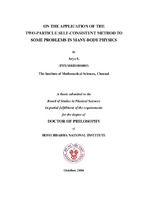- DSpace Home
- →
- IMSc Theses/ Dissertations
- →
- IMSc Theses/ Dissertations
- →
- View Item
JavaScript is disabled for your browser. Some features of this site may not work without it.
On the Application of the Two-Particle Self-Consistent Method to some Problems in Many-Body Physics[HBNI Th120]
Arya, S.
Advisor:
Syed R. Hassan
Degree:
Ph.D
Main Subject:
Physics
Institution:
HBNI
Year:
2017
Pages:
118p.
Date:
2017
Abstract:
The two-particle self-consistent approximation (TPSC) is a non-perturbative semi-analytical method used to study the single-band Hubbard model from weak to intermediate coupling. This method satisfies many physical constraints like the conservation of spin and charge, Pauli principle, and the Mermin-Wagner theorem. The highlight of TPSC is that, it takes into account the physics of the long-ranged antiferromagnetic fluctuations which develop in the system as interaction is increased, at lower temperatures. The crossover to the renormalized classical regime, and the
appearance of a pseudogap in the single-particle density of states is thus described by TPSC. TPSC can also describe pairing mediated by these large antiferromagnetic fluctuations.
In this thesis, I study three problems using this approach. The debate over the existence of a spin liquid in the half-filled Hubbard model on the honeycomb lattice demands the analysis of this problem using a method which can work at weak to intermediate coupling, simultaneously capturing the physics of the antiferromagnetic fluctuations. In order to apply TPSC to this problem, we extend TPSC to the two-band case. After stating definitons for the ferromagnetic and antiferromagnetic susceptibilties, and corresponding correlation lengths, we evaluate these for
various values of interaction and temperature. The antiferromagnetic correlation length increases
rapdily as the interaction increases, for lower temperatures. When this correlation length exceeds the thermal de Broglie wavelength, the system enters the renormalized classical regime. This
crossover is extended to the zero temperature to extract the critical value of interaction for the semimetal to antiferromagnet transition. Since the estimates for the Mott transition are larger, we rule out the spin liquid phase. The dynamical critical exponent is also evaluated.
The possibility of the application of reversible strain upto 20 percent on graphene and the presence
of sizable interactions in graphene motivates us to look at the Hubbard model on the honeycomb lattice under uniaxial strain. As strain is applied along the zigzag direction, the Dirac point moves
from K to M in the Brillouin zone, and at a critical strain a gap opens up at M. Beyond critical strain, the system is a bandgap insulator. As seen from the self-energy, close to critical strain, the
large antiferromagnetic fluctuations, drive the system to a pseudogapped metal. The nematic susceptibility close to critical strain, at large values of interaction diverges as temperature approaches zero, signalling a quantum phase transition. This quantum phase transition can be
observed by looking at magneto-volume, thermal expansion and magnetic Gruneisen coefficients.
Beyond critical strain, the fluctuations never grow large, restricting the features of quantum criticality, influenced by the fluctuations, close to critical strain.
We revisit the problem of pairing on the square lattice Hubbard model with extended hopping, a model which describes the electron doped high temperature superconductor NCCO. TPSC is apt to
look at the weakly correlated e-doped cuprates. We see that hopping to the second and third nearest neighbors extends the range of commensurate fluctuations around half-filling. The crossover plot to
the renormalized classical regime, as a function of filling can be extrapolated to the zero temperature to get the quantum critical point where antiferromagnetism ends. The superconducting
transition temperature shows a monotonic dependence on the filling, this is because the pseudogap effect is limited to the hotspots and is not catastrophic to pairing.
Files in this item
This item appears in the following Collection(s)
-
IMSc Theses/ Dissertations
IMSc Theses/ Dissertations
Search DSpace
Browse
-
All of DSpace
-
This Collection
